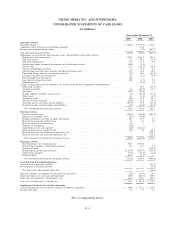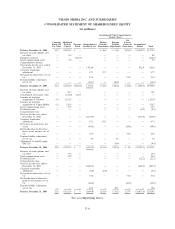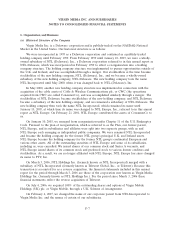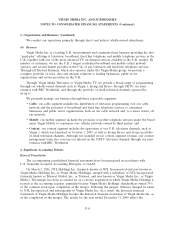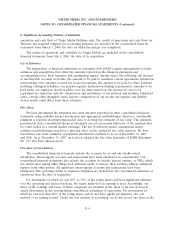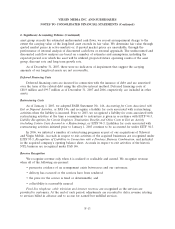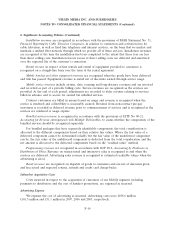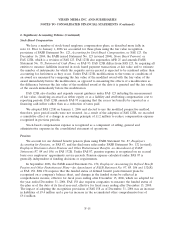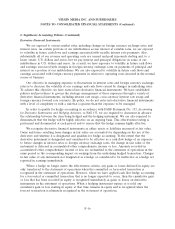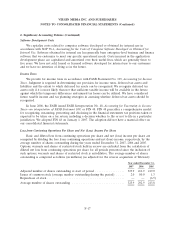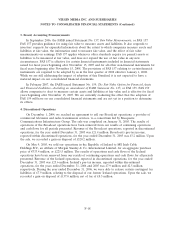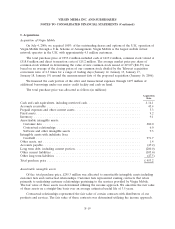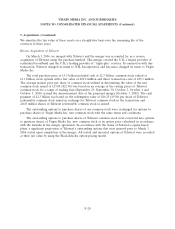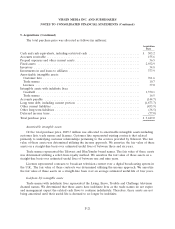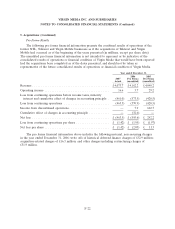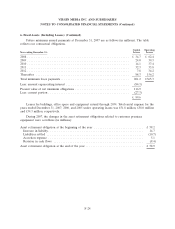Virgin Media 2007 Annual Report Download - page 101
Download and view the complete annual report
Please find page 101 of the 2007 Virgin Media annual report below. You can navigate through the pages in the report by either clicking on the pages listed below, or by using the keyword search tool below to find specific information within the annual report.VIRGIN MEDIA INC. AND SUBSIDIARIES
NOTES TO CONSOLIDATED FINANCIAL STATEMENTS (Continued)
2. Significant Accounting Policies (Continued)
Stock-Based Compensation
We have a number of stock-based employee compensation plans, as described more fully in
note 12. Prior to January 1, 2006 we accounted for these plans using the fair value recognition
provisions of FASB Statement No. 123, Accounting for Stock-Based Compensation, or FAS 123. On
December 16, 2004, the FASB issued Statement No. 123 (revised 2004), Share Based Payment, or
FAS 123R, which is a revision of FAS 123. FAS 123R also supersedes APB 25 and amends FASB
Statement No. 95, Statement of Cash Flows, or FAS 95. FAS 123R differs from FAS 123, by requiring all
entities to measure liabilities incurred in stock based payment transactions at fair value and to estimate
the number of instruments for which the requisite service period is expected to be rendered rather than
accounting for forfeitures as they occur. Under FAS 123R, modifications to the terms or conditions of
an award are measured by comparing the fair value of the modified award with the fair value of the
award immediately before the modification, as opposed to measuring the effects of a modification as
the difference between the fair value of the modified award at the date it is granted and the fair value
of the awards immediately before the modification.
FAS 123R also clarifies and expands current guidance under FAS 123 including the measurement
of fair value, classifying an award as either equity or as a liability and attributing compensation cost to
reporting periods. FAS 123R amends FAS 95 requiring that the excess tax benefits be reported as a
financing cash inflow rather than as a reduction of taxes paid.
We adopted FAS 123R on January 1, 2006 and elected to use the modified prospective method,
therefore, prior period results were not restated. As a result of the adoption of FAS 123R, we recorded
a cumulative effect of a change in accounting principle of £1.2 million to reduce compensation expense
recognized in previous periods.
Stock-based compensation expense is recognized as a component of selling, general and
administrative expenses in the consolidated statement of operations.
Pensions
We account for our defined benefit pension plans using FASB Statement No. 87, Employer’s
Accounting for Pensions, or FAS 87, and the disclosure rules under FASB Statement No. 132 (revised),
Employers Disclosures about Pensions and Other Postretirement Benefits, an Amendment of FASB
Statements 87, 88 and 106, or FAS 132R. Under FAS 87, pension expense is recognized on an accrual
basis over employees’ approximate service periods. Pension expense calculated under FAS 87 is
generally independent of funding decisions or requirements.
In September 2006, the FASB issued Statement No. 158, Employers’ Accounting for Defined Benefit
Pension and Other Postretirement Plans—An Amendment of FASB Statement No. 87, 88, 106 and 132(R),
or FAS 158. FAS 158 requires that the funded status of defined benefit postretirement plans be
recognized on a company’s balance sheet, and changes in the funded status be reflected in
comprehensive income, effective for fiscal years ending after December 15, 2006, which we adopted for
the year ended December 31, 2006. FAS 158 also requires companies to measure the funded status of
the plan as of the date of its fiscal year-end, effective for fiscal years ending after December 15, 2008.
The impact of adopting the recognition provisions of FAS 158 as of December 31, 2006 was an increase
in liabilities of £9.4 million and a pre-tax increase in the accumulated other comprehensive loss of
£9.4 million.
F-15


